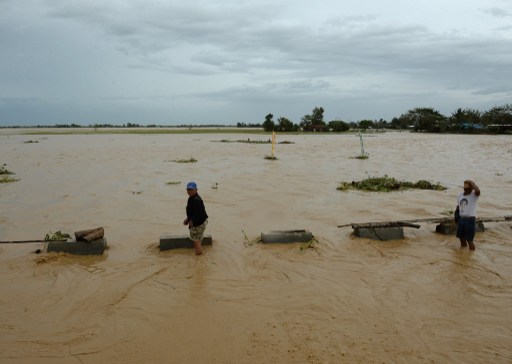Global study lists PH provinces at most risk of climate damage

Residents wade through a flooded highway (foreground) and rice fields in Santa Rosa town, Nueva Ecija province, north of Manila on Oct. 19, 2015, a day after Typhoon Koppu hit Aurora province. (File photo by TED ALJIBE / Agence France-Presse)
MANILA, Philippines — Several Philippine provinces, most of them in Northern Luzon, are the most at risk of damage from extreme weather to their buildings and other property developments in about two decades, according to a new report on climate risk.
According to the 2023 Gross Domestic Climate Risk ranking by the Sydney-based climate-change research firm The Cross Dependency Initiative (XDI), Pangasinan, Pampanga, Nueva Ecija, Cagayan and Tarlac are the five most at-risk provinces based on their aggregated damage ratio (ADR)—or the total amount of damage to their built environment because of climate-induced disasters such as flooding and rising sea levels.
XDI defines the damage ratio as an indicator of the province’s annual average loss from extreme weather damage to property.
Metro Manila, Bulacan, Isabela, Davao del Sur and Leyte round up the rest of the 10 most at-risk provinces.
Together they join the 600 most vulnerable provinces out of the 2,639 jurisdictions worldwide covered by the report.
Article continues after this advertisementChina tops list
The study said that 80 percent of the top 50 most at-risk states and provinces are in China, the United States and India.
Article continues after this advertisementThe ranking also showed that most of the states and provinces at the highest risk of climate disaster are economically important to their countries and to global trade.
Nine Chinese provinces, including Jiangsu, Shandong, and Hebei, that account for more than half of the country’s economy take up the top nine spots that are most likely to suffer trillions of dollars in damage by 2050, as natural disasters become more extreme and frequent.
The coastal US state of Florida ranked 10th in the world.
But XDI’s report is also the latest among several studies that have shown the Philippines’ vulnerability to climate change.
Just last year, the Philippines topped 193 countries around the world in terms of disaster risk from extreme weather and other climate-induced events.
The report is based on global climate models, combined with local weather and environmental data and engineering archetypes which are used to calculate the damage to the built environment from eight different extreme weather hazards.
It aims to capture the risk of extreme weather and climate change on infrastructure in cities, provinces, and countries around the world using consistent and comparable metrics.
Climate risk at an ecosystem level was analyzed to see the impacts of climate-related failures in power, water, and transport infrastructure.
XDI said the countries on the list need to acknowledge their physical risks, take immediate and effective measures to adapt, and take climate risks into consideration when making investment decisions.